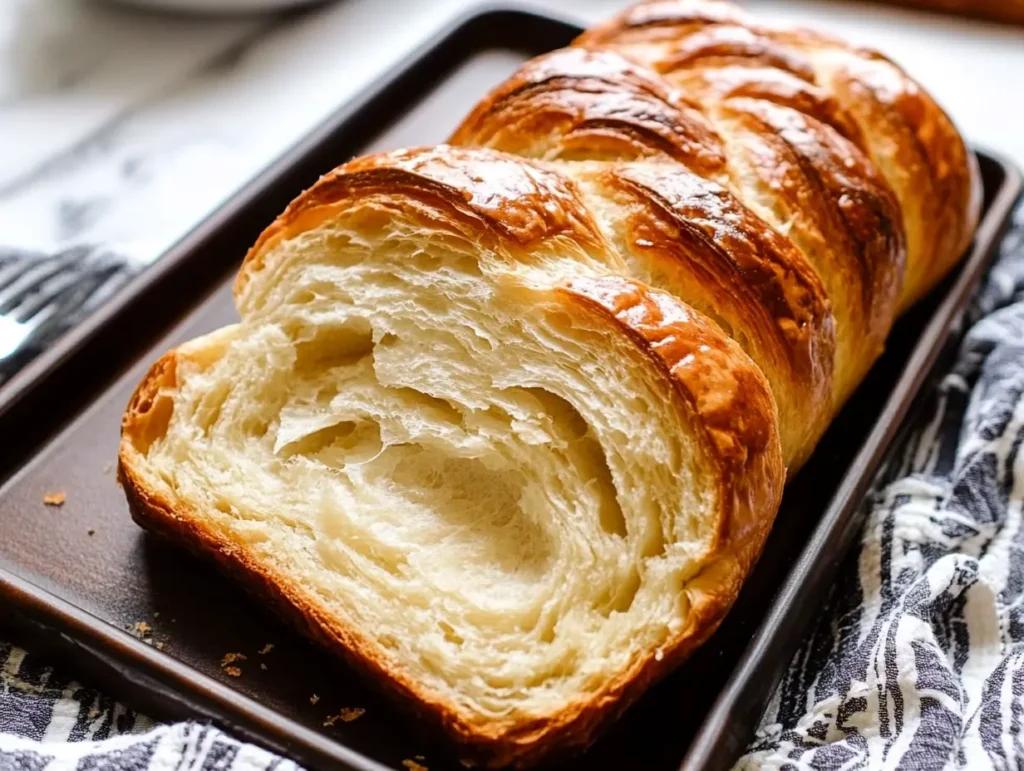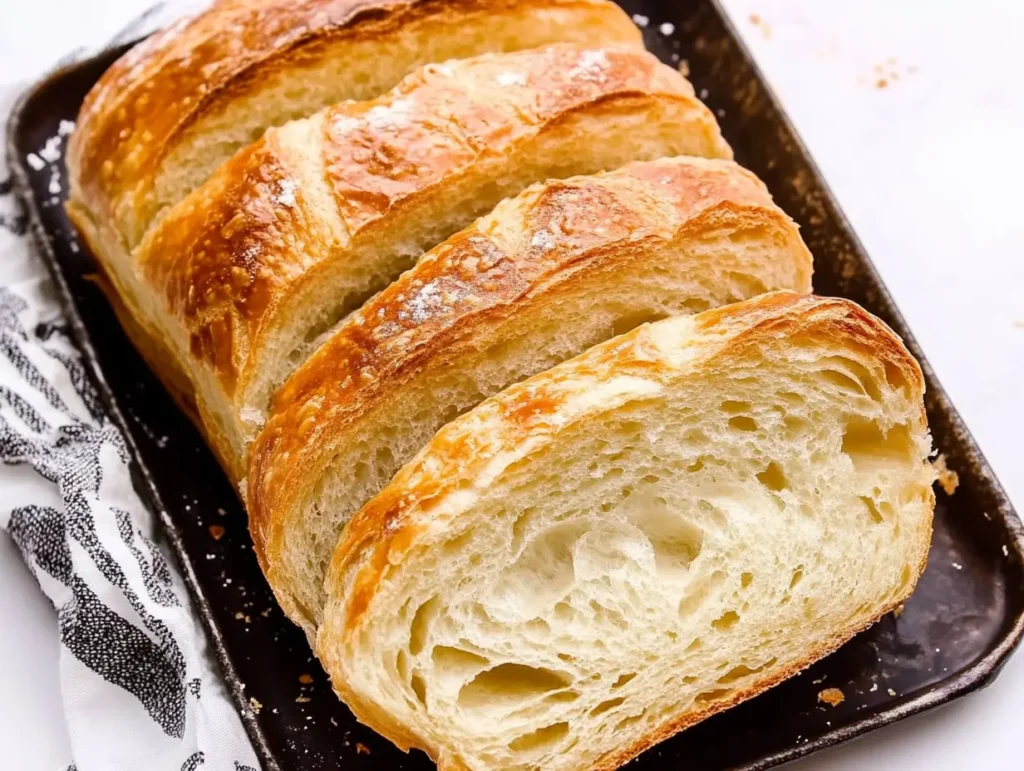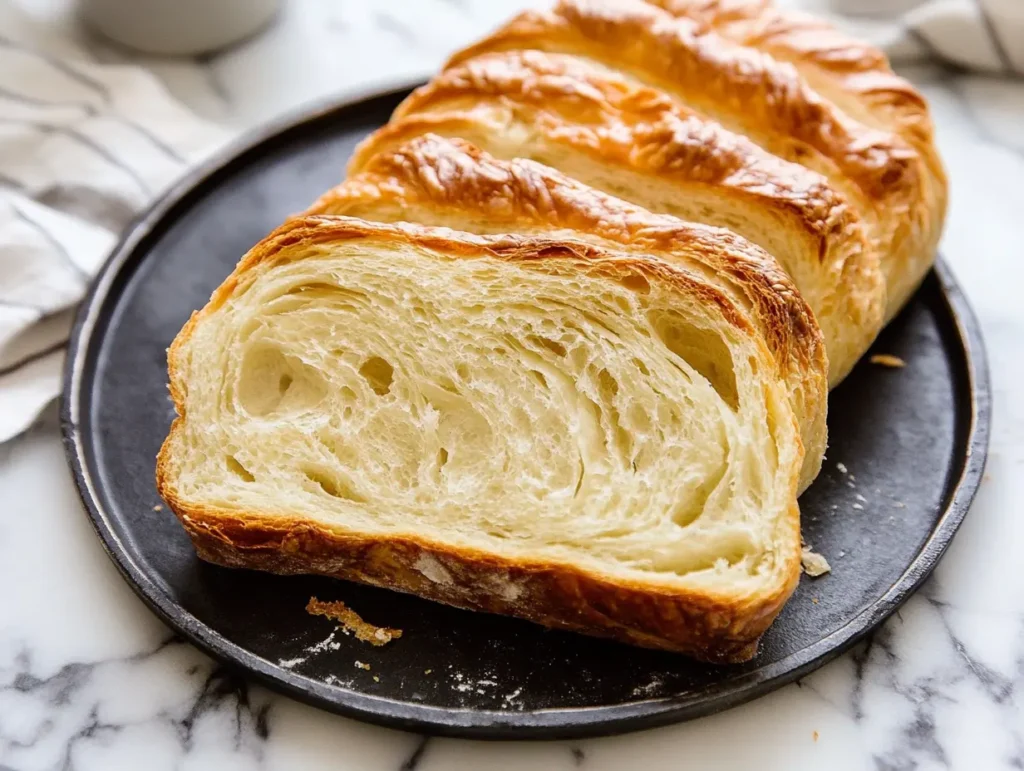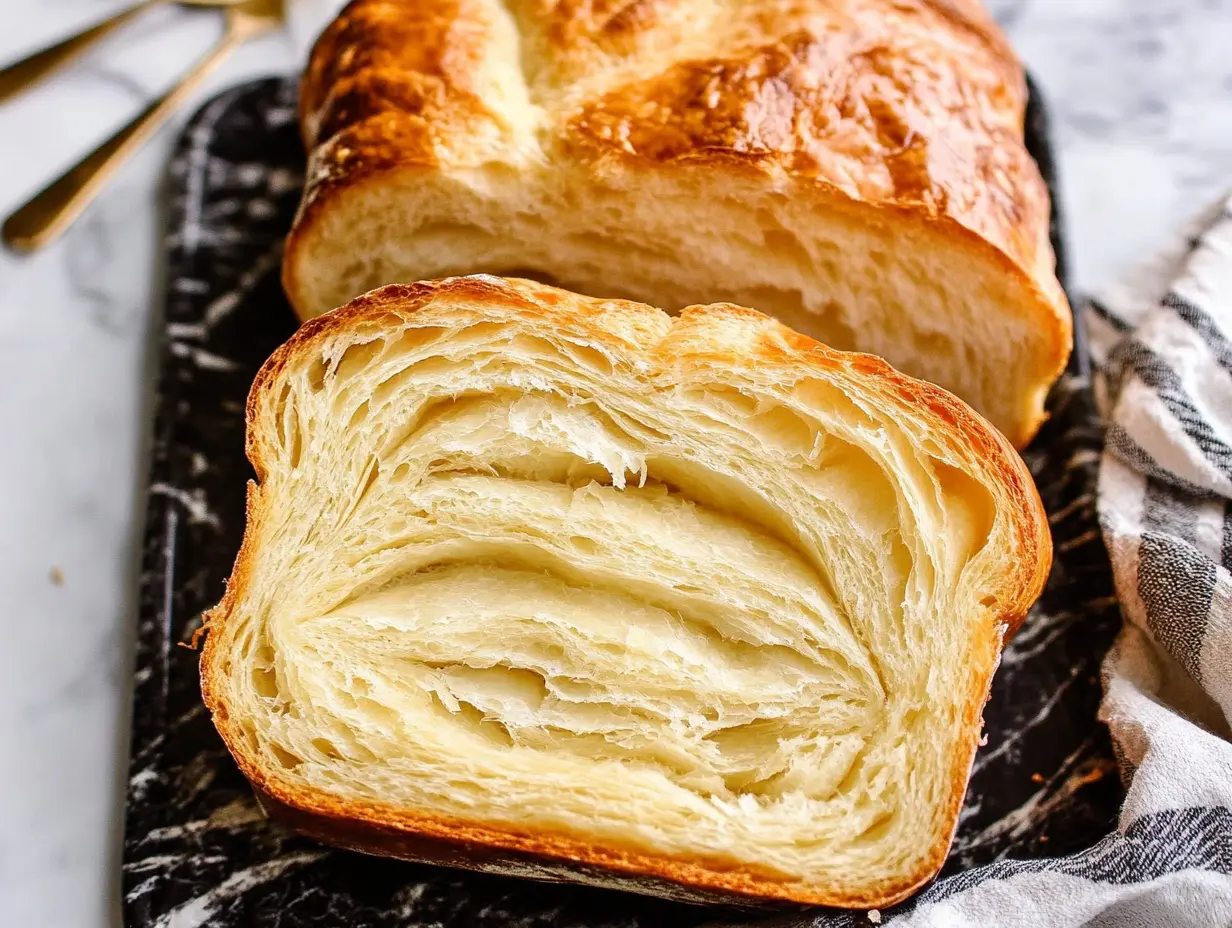Croissant bread has become a global icon of baking, loved for its buttery flavor, flaky layers, and crescent shape. While it’s closely associated with French cuisine, the croissant has a rich and fascinating history, spanning centuries and crossing borders. This guide explores every aspect of croissant bread, from its origins to its influence on modern baking, international adaptations, and frequently asked questions. Along the way, we’ll ensure clarity by using active voice, transitional phrases, and familiar words.

1. The History of Croissant Bread
1.1 The Austrian Roots: Kipferl
Many people associate croissant bread with France, but its true origins lie in Austria. Its ancestor, the kipferl, was a crescent-shaped pastry that dates back to at least the 13th century. Unlike modern croissants, kipferl were simpler, denser, and lacked the signature flaky texture created by laminated dough. Bakers made kipferl with sugar or honey and often flavored them with nuts or spices.
The kipferl gained historical significance during the Siege of Vienna in 1683, a pivotal battle between the Ottoman Empire and European forces. According to legend, Austrian bakers, working late at night, heard Ottoman soldiers tunneling under the city. The bakers alerted authorities, thwarting the attack and helping secure victory. To celebrate, they created crescent-shaped pastries that symbolized the Ottoman crescent moon.
1.2 How the Croissant Reached France
The story of the croissant continued when the Austrian Princess Marie Antoinette married King Louis XVI of France in 1770. She brought her love for kipferl to the French court, where local bakers began to experiment with the recipe. Over time, French bakers refined the pastry, introducing laminated dough, which involves folding butter into dough multiple times to create thin layers.
By the 19th century, the croissant had evolved into the light, flaky pastry we recognize today. Its name, derived from the French word for “crescent,” reflects its shape. The croissant quickly gained popularity in France and became a staple of French bakeries.
1.3 Modern Popularity
Today, croissant bread is a global phenomenon. While its classic French form remains iconic, croissants have also inspired countless variations and innovations around the world. They symbolize the artistry of baking and continue to adapt to modern tastes.
2. What Makes Croissant Bread Unique?
2.1 Distinctive Features
Several features make croissant bread stand out from other pastries:
- Flaky Texture: The lamination process creates thin, crisp layers that separate as the croissant bakes.
- Rich Flavor: Croissants use a high butter content, resulting in a luxurious, buttery taste.
- Crescent Shape: While straight croissants exist, the crescent shape remains a defining characteristic.
- Golden Crust: An egg wash applied before baking gives croissants their shiny, golden finish.
- Airy Interior: The honeycomb-like structure inside makes croissants light and soft.
2.2 Laminated Dough: The Secret to Flakiness
The croissant’s signature flakiness comes from laminated dough, a technique that requires skill and precision. Bakers fold butter into the dough, roll it out, and repeat the process several times. This creates hundreds of thin layers of butter and dough. When baked, the butter melts and releases steam, which lifts and separates the layers.
2.3 How Croissants Differ from Other Pastries
Croissants differ from other pastries in several ways. For example:
- Croissant dough includes yeast, which makes the dough rise and gives it a softer texture.
- Puff pastry, while similar in preparation, lacks yeast and results in a crisper, denser texture.
- Unlike muffins or scones, croissants require more complex preparation, showcasing a higher level of skill.

3. Croissant Bread Around the World
3.1 France: The Croissant’s Spiritual Home
In France, croissants are a cornerstone of breakfast culture. They are often served plain or with simple accompaniments like butter, jam, or coffee. French bakeries distinguish between:
- Croissants au Beurre: Made with pure butter, these are considered the gold standard.
- Croissants Ordinaires: Made with margarine, these are more economical but less flavorful.
3.2 Italy: Cornetti
In Italy, croissants are called cornetti. These pastries are softer and sweeter than their French counterparts. Italians often fill cornetti with jam, custard, or chocolate, creating a more indulgent treat. Cornetti are commonly enjoyed with espresso or cappuccino for breakfast.
3.3 Spain: Cruasán
The Spanish version, cruasán, retains the classic French croissant’s shape but often includes regional twists. For instance, Spanish bakeries may glaze croissants with a sugary coating or fill them with ham and cheese for a savory option.
3.4 North and South America
In the Americas, croissants have inspired creative adaptations:
- United States: American bakeries offer large croissants filled with a variety of ingredients, from almond cream to ham and eggs. The cronut, a hybrid of a croissant and a doughnut, became a sensation in New York.
- Latin America: Croissants often feature local flavors, such as dulce de leche, guava, or regional cheeses.
3.5 Middle East and Asia
In the Middle East, croissants are infused with local flavors like pistachio, rose water, and za’atar. Meanwhile, in Asia, countries such as Japan and South Korea emphasize artistry, offering croissants filled with matcha, red bean, or spicy curry. Rainbow-colored croissants and other visually stunning variations are also popular.
4. Croissant Bread in Modern Baking
4.1 Innovations in Croissant Recipes
Modern bakers constantly reinvent croissants to keep them exciting. For example:
- Flavored Dough: Bakers experiment with chocolate, matcha, or charcoal-infused dough.
- Unique Fillings: Popular options include salted caramel, seasonal fruits, and savory fillings like truffle cheese.
- Hybrid Pastries: Beyond the cronut, hybrids like croissant waffles or croissant ice cream cones have gained popularity.
4.2 The Art of Artisanal Croissants
The rise of artisanal baking has elevated the croissant to new heights. Many bakers now prioritize high-quality ingredients, traditional techniques, and innovative presentations. Organic butter, stone-milled flour, and hand-crafted dough are often used to produce croissants with unparalleled flavor and texture.
4.3 Healthier Croissant Options
As consumers become more health-conscious, bakers have developed croissants that cater to dietary needs:
- Whole-Grain Croissants: These use whole-grain flour for added fiber and nutrients.
- Vegan Croissants: Plant-based butters and non-dairy milk make these suitable for vegans.
- Gluten-Free Croissants: Alternative flours, such as almond or rice flour, help create gluten-free versions.
5. Popular Uses for Croissant Bread
5.1 Breakfast Staples
Croissants are a classic breakfast choice. They are often served plain, paired with butter and jam, or filled with chocolate, ham, or cheese. Croissants pair well with coffee or tea, making them a popular morning treat.
5.2 Savory Dishes
Croissants add a touch of luxury to savory dishes. For instance:
- Croissant Sandwiches: These are filled with meats, cheeses, vegetables, or eggs.
- Savory Bread Pudding: Croissants are combined with cheese, cream, and herbs to create a rich, baked dish.
- Casseroles: Layering croissants in casseroles adds a buttery, flaky texture.
5.3 Desserts
Croissants are also the foundation for many desserts:
- Almond Croissants: Filled with almond paste and topped with sliced almonds.
- Croissant Bread Pudding: A decadent dessert made by soaking croissants in custard and baking them.
- Hybrid Creations: Cronuts, croissant ice cream cones, and other inventive treats.

6. Frequently Asked Questions About Croissant Bread
6.1 Is Croissant Bread the Same as Puff Pastry?
No, croissant bread differs from puff pastry. Croissant dough includes yeast, giving it a soft and airy texture. Puff pastry, which lacks yeast, has a crispier and denser texture.
6.2 Why Is Croissant Bread Flaky?
The flakiness comes from the lamination process. Layers of butter and dough trap steam during baking, which separates the layers and creates the croissant’s light, crisp texture.
6.3 Can Croissants Be Gluten-Free?
Yes, gluten-free croissants are possible. Bakers use alternative flours, like almond or rice flour, to recreate the texture. However, achieving the same flakiness as traditional croissants can be challenging.
6.4 How Do You Pronounce “Croissant”?
In French, it’s pronounced “kwah-SAHN,” with a silent “t.” In English, many people pronounce it as “kruh-SAHNT,” which is widely understood.
6.5 Why Is It Called a Croissant?
The name “croissant” comes from the French word for “crescent,” reflecting its iconic shape. This shape also ties back to its origins, symbolizing the Ottoman crescent moon.
6.6 What Is the Closest Equivalent to Croissant Bread?
The Austrian kipferl is the closest equivalent to croissant bread. While similar in shape, kipferl are denser and lack laminated dough.
For those with dietary restrictions, the gluten-free croissant provides an excellent alternative, ensuring that everyone can enjoy this beloved pastry. If you’re curious about creative ways to bake croissant dough, you might find inspiration in the croissant bread loaf recipe, which transforms the traditional pastry into a loaf-style version perfect for sandwiches or toast. These variations showcase the croissant’s adaptability and widespread appeal.
7. Conclusion
Croissant bread is more than just a pastry—it represents a blend of history, artistry, and cultural significance. From its Austrian origins as the kipferl to its refinement in France and global adaptations, the croissant tells a story of culinary evolution. Its versatility allows it to shine as a breakfast staple, a savory dish, or the foundation for innovative desserts.
Modern baking continues to push the boundaries of what croissants can be, introducing bold flavors, creative hybrids, and healthier alternatives. Despite these changes, the croissant remains a timeless symbol of craftsmanship and indulgence.

